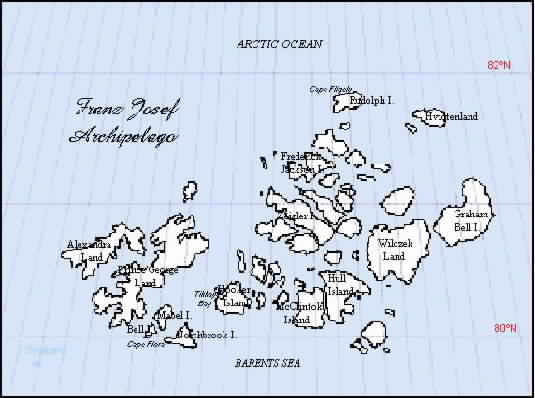|
|
|
 |
 |
 |
| Franz Josef Land [Russian: Zemlya Frantsa Iosifa] is an archipelago of approximately 100 or so islands lying roughly between latitudes 80 and 82 degrees North. The 1872-74 Austro-Hungarian Weyprcht-Payer expedition discovered the island group in 1873 and named it after the Austrian Emperor Francis Joseph I. In 1886, the Norwegians Fritjof Nansen and Hjalmar Johansen returned to Franz Josef Land after leaving the ship Fram at 84ºN in |
| the Arctic Ocean and traveling by dogsled to 86º13'N, a record farthest north. In the spring of 1897, a memorable chance meeting took place at Cape Flora, Northbrook Island between Nansen and the British explorer Frederick Jackson of the 1894-97 Jackson-Harmsworth expedition. As a result of this encounter, Jackson was able to return Nansen and Johansen safely to civilization. |
| For more information: Nansen's classic book FARTHEST NORTH is recommended. |
|
| Several other early expeditions that surveyed and mapped Franz Josef Land include: |
| 1898-99 WALTER WELLMAN (American) |
| 1899-1900 The Duke of Abruzzi (Italian) |
| 1902-03 Ziegler-Baldwin (American) |
| 1903-05 Ziegler-Fiala (American) |
|
| Some other names associated with Franz Josef Land include: |
| The Russian navigator Valarian Albanov who described in a recently published translation of his book, In the Land of the White Death, a harrowing 1914 trek across the ice from the Russian ship Santa Ana ice-locked for two years north of Franz Josef Land. Albanov and a sole surviving companion eventually made their way to Cape Flora where they were rescued by a passing ship. |
| For more information: IN THE LAND OF THE WHITE DEATH |
| |
|
| In 1931, the German airship Graf Zeppelin made an historic exchange of mail with the Russian icebreaker Malygin at Tikhaya Bay on Hooker Island, then the site of the world's most northerly weather station. Following the exchange of mail, the Graf Zeppelin undertook an extensive aerial survey and mapping of Franz Josef Land. During this flight the Graf Zeppelin reached its northernmost point, Rudolf Island approximately 500 nautical miles from the North Pole. |
| For more information: THE 1931 POLAR FLIGHT OF THE AIRSHIP GRAF ZEPPELIN |
|
| In 1937, the Russian SP-1 expedition established a base on Rudolf Island prior to flying in four 4-engine cargo planes to the North Pole for the purpose of establishing a drifting ice station near the pole. This was the first landing on the ice in the near vicinity of the North Pole. |
| For more information: WHO WAS FIRST AT THE NORTH POLE |
|
| Also recommended: Mikhail Vodopyanov's book, WINGS OVER THE ARCTIC Vodopyanov was the pilot of the first plane to fly from Rudolf Island and land near the North Pole. |
|
| FRANZ JOSEF LAND WEATHER |
| For weather from Tikhaya Bay, Hooker Island, click here. |
 |




